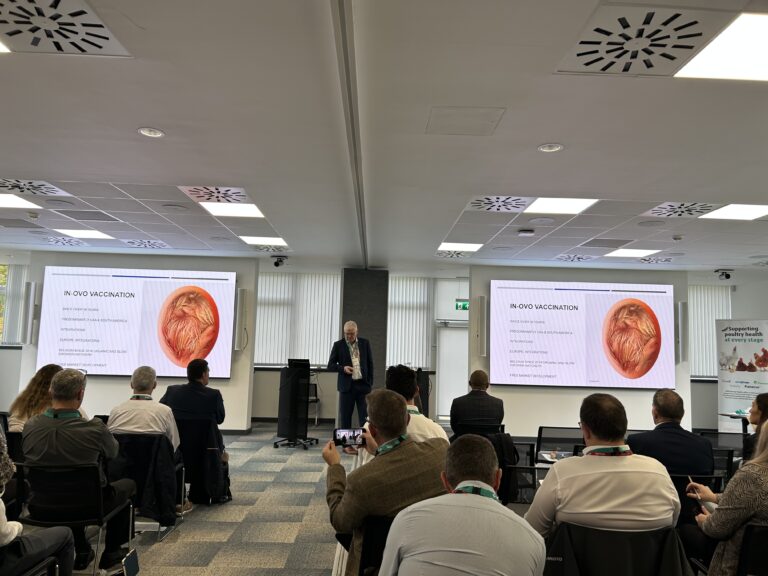Insights from the MSD Animal Health hatchery conference 2025
Poultry producers and hatchery managers and technical specialists gathered in Milton Keynes on 15 October for the MSD Hatchery Conference, an event that brought together experts from across the industry to discuss the latest science, technology and practical approaches for improving chick quality and bird performance.
The day covered every stage from egg handling to vaccination. Speakers included Dr Barrie Fleming, technical director for poultry at MSD; Kristof Van Hoye, Pehevaxx project manager; John Shiels, MSD poultry technical and sales manager; Vincent Fevrier, sales and marketing Europe, Targan; and Ron Meijerhof, consultant at Poultry Performance Plus.
Across their presentations, one clear message emerged: attention to detail at the hatchery shapes the health and productivity of a flock.
Hatchery precision
Opening the event, Dr Barrie Fleming, stressed that successful vaccination depends as much on precision and planning as on the products themselves. The effectiveness of vaccines relies on correct storage, handling, and administration.
Fleming highlighted that common diseases such as Newcastle disease, infectious bronchitis, and Gumboro (IBD) continue to threaten productivity, making vaccination a cornerstone of biosecurity. However, “vaccination only works if it’s done right,” he said. Poor mixing, slow use, or warm conditions can weaken live vaccines, leaving flocks unevenly protected.
Water vaccination, often viewed as simple, was described as technically demanding. Clean drinker lines, stabilisers, and careful timing are essential to ensure every bird receives an equal dose. Spray vaccination offers strong respiratory protection, but success depends on droplet size, equipment calibration, and even application.
For inactivated vaccines given by injection, hygiene and staff training are critical to prevent abscesses or infection. Monitoring antibody levels confirms whether immunity has developed as expected.
Fleming urged producers to plan vaccination programmes carefully, keep detailed records, and use diagnostic tools such as PCR to track results.
Belgium’s in-ovo revolution
Kristof Van Hoye, Pehevaxx project manager, spoke about how Belgium’s poultry sector has embraced in-ovo vaccination, a method where chicks are vaccinated inside the egg.
The shift began in 2018, and by 2022, over 100 million chicks were vaccinated in-ovo. The model is simple: farmers pay vets for “in-ovo vaccinated chicks,” hatcheries are compensated for the procedure, and vets retain oversight of vaccine use and quality.
Cleanliness remains critical. Belgium’s “H-Service” audit programme inspects hatcheries quarterly, using ATP testing and biofilm detection to monitor hygiene inside vaccination lines.
“Every vaccinated chick carries the reputation of everyone involved,” said van Hoye. “Clean systems and calm handling make the difference.”
From egg to chick
John Shiels of MSD highlighted how small improvements in egg storage and incubation can dramatically boost hatch rates and chick quality.
Proper egg storage is critical. Eggs should be set within seven days of laying, kept cool, dry, and turned at least once daily to prevent the yolk from sticking to the shell membrane. Each extra day in storage can raise embryo mortality by up to 2%. “Moisture breeds bacteria that can ruin entire batches.”
Once incubation begins, temperature, humidity, and ventilation must be precisely managed. Ideal conditions include 37.5°C and 50–55% humidity, with gentle airflow to supply oxygen and remove carbon dioxide.
The final hatch phase requires close attention: slightly lower temperatures, higher humidity, and clean, disinfected equipment. Healthy chicks emerge dry, alert, and strong – clear signs of good incubation.
Technology in the hatchery
Vincent Fevrier, sales and marketing Europe, Targan explored how modern automation can transform hatchery efficiency and welfare outcomes.
Its flagship product, WingScan, uses artificial intelligence and computer vision to identify the sex of day-old chicks without physical handling, processing up to 120,000 chicks per hour with 97–99% accuracy.
The system helps hatcheries separate males and females early, allowing tailored feeding and management that improve flock uniformity and product quality. Over 40 WingScan units are already in operation worldwide, with rapid adoption in Europe and ongoing trials in Latin America and Asia.
Building on this success, the company is developing a fully automated vaccination system that uses 3D imaging to precisely target each chick’s eye region, handling up to 60,000 chicks per hour.
Incubation Management
Hatchery specialist Ron Meijerhof, consultant at Poultry Performance Plus reminded delegates of what they do: “We don’t hatch eggs – we manage living embryos.” His presentation emphasised how modern broiler hatcheries can boost performance by precisely managing temperature, oxygen, and humidity.
“The embryo still expects a mother hen,” he said, highlighting that even small shifts in temperature or airflow can alter chick health. Embryos generate their own heat, and poor oxygen exchange can quickly cause stress, leading to weak hearts, poor legs, and lower survival rates.
Research supports his claims. Studies show that a difference of just 1–2°F in eggshell temperature can affect feed conversion and growth weeks after hatching. Likewise, improper humidity or airflow can drain energy from developing chicks and reduce overall flock performance.
Welfare, efficiency and quality
Across all presentations, a consistent set of priorities emerged: chick welfare, biosecurity, and consistency at every stage of production.
Speakers stressed that technology and vaccines are only effective when supported by strong management practices – clean equipment, trained staff, careful monitoring, and a culture of continuous improvement.
As Dr Fleming concluded: “The best results come from people who care; those who treat every egg, every chick, and every vaccine dose as critical to the flock’s success.”


